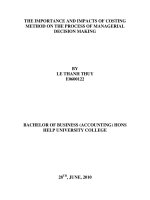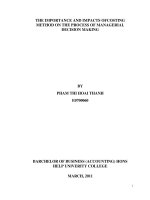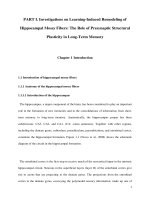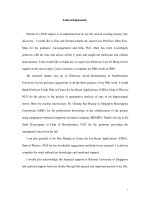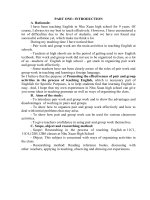Topics the process of shopping decision makingof customers before purchase
Bạn đang xem bản rút gọn của tài liệu. Xem và tải ngay bản đầy đủ của tài liệu tại đây (4.01 MB, 35 trang )
<span class="text_page_counter">Trang 1</span><div class="page_container" data-page="1">
<b>SUBJECT: CONSUMER BEHAVIOR</b>
<b>TOPICS: THE PROCESS OF SHOPPING DECISION MAKING</b>
OF CUSTOMERS: BEFORE PURCHASE
<b>UNIVERSITY OF ECONOMICS AND LAWFACULTY OF BUSINESS ADMINISTRATION</b>
</div><span class="text_page_counter">Trang 2</span><div class="page_container" data-page="2">First and foremost, our group would like to sincerely express our gratitude to Ms. Cung Thuc Linh. As we navigated through the study and exploration of this subject,
express our thanks for the valuable knowledge you shared right from the beginning, as well as your teachings on applying theory to practical situations. Your guidance not only deepened our understanding of the subject but also allowed us to gain profound insights into social phenomena, ultimately aiding in the completion of our essay. In our quest for understanding, we turned to books, engaged in group discussions, and applied the knowledge acquired from the course to analyze and complete our essay. During the essay writing process, mistakes are unavoidable, so we hope to receive valuable feedback from you in order to refine and perfect our work.
Once again, from the bottom of our hearts, we would like to express our appreciation for all of your wonderful assistance with our education and personal growth.
<i>Group 6</i>
</div><span class="text_page_counter">Trang 3</span><div class="page_container" data-page="3"><b>CHAPTER 1: OVERVIEW OF THE ESSAY...</b>
<b>1. Overview of the essay...</b>
<b>2. Research objective...</b>
<b>3. Research subject...</b>
<b>4. Essay structure...</b>
<b>CHAPTER 2: THEORETICAL BASIS AND APPLICATIONS...</b>
<b>I. Overview of The Cognitive Decision-Making Process...</b>
<b>1. Definition...</b>
<b>2. Model of consumer behavior process...</b>
<b>3. Types of consumer decision-making processes...</b>
3.1. Habitual decision-making...
3.2. Limited decision-making...
3.3. Extended decision-making...
Habitual decision-making...
<b>II. NEED RECOGNITION...</b>
<b>1. Status of Need Recognition...</b>
<b>1.1. The Consumer Need Recognition Process...</b>
1.1.1. The Desired State...
1.1.2. The Actual State...
1.1.3. The Desire to Resolve Recognized Problems...
<b>1.2. Factors affecting the Desired State and Actual State...</b>
<b>2. Marketing application of need recognition...</b>
<b>2.1. Discovering Consumer Problems...</b>
<b>2.2. Responding to Consumer Problems...</b>
<b>III. Information Search...</b>
<b>1. Overview of Information search...</b>
<b>2. Internal information search...</b>
2.1. Level of internal information search...
2.2. Type data retrieved via an internal search...
2.3. The precision of the inner search...
<b>3. External information search (Search for information from the environment)...</b>
3.1. Types of external searches...
3.2. Information sources...
3.3. Extent of performing external search...
3.4. Type of information collected in external searches...
3.5. How to conduct external information search...
<b>4. Marketing application of information search...</b>
4.1. Improving the information quality controllable source...
4.2. Viral Marketing...
4.3. Other marketing applications...
<b>CONCLUSION...</b>
</div><span class="text_page_counter">Trang 4</span><div class="page_container" data-page="4"><b>TABLE OF FIGURES</b>
Figure 1. Engel, Blackwell and Miniard model of Consumer behavior, 2000 Figure 2. Five-stage buying decision process model
Figure 3. MAO and the types of decision-making processes of consumers Figure 4. The Process of Need Recognition
Figure 5. Problem Recognition: Shifts In Actual Or Ideal States
Figure 6. Marketers often attempt to cause consumers to recognize potential problems for which the marketer has a solution.
</div><span class="text_page_counter">Trang 5</span><div class="page_container" data-page="5"><b>CHAPTER 1: OVERVIEW OF THE ESSAY</b>
<b>1. Overview of the essay </b>
To achieve their goals, marketing professionals strive to study consumer behavior to influence their purchasing decisions. This is driven by the intense competition among businesses in today's market, making it more important than ever to understand customer desires to gain a competitive edge.
By meticulously analyzing customer trends and behaviors, businesses can accurately identify what customers truly need and find suitable solutions for these needs. This helps them attract customer interest and persuade them to choose their products or services over those of their competitors.
Starting from the significance of understanding customers, we have chosen the topic "Customer’s purchase decision process: Before buying" to investigate its theoretical basis and practical implications.
<b>2. Research objective </b>
The research objective of this topic is to explore the theoretical foundations of the “Customer’s purchase decision process: Before buying” across the two stages of need, information search and the application of practical aspects into the business's marketing strategies.
<i><b>3. Research subject: Customer’s purchase decision process: Before buying</b></i>
<b>4. Essay structure </b>
The content of the report will include 3 main parts:
<b>-PART I: OVERVIEW OF THE CONSUMER DECISION-MAKINGPROCESS</b>
<b>-PART II: NEED RECOGNITION-PART III: INFORMATION SEARCH</b>
</div><span class="text_page_counter">Trang 6</span><div class="page_container" data-page="6"><b>CHAPTER 2: THEORETICAL BASIS AND APPLICATIONS</b>
<b>I.Overview of The Cognitive Decision-Making Process</b>
<b>1. Definition</b>
The term "cognitive decision-making" indicates that a consumer meticulously assesses the characteristics of a range of products, brands, or services by gathering as much information as they can, taking into account their existing knowledge about a product, and methodically balancing the pros and cons of each option until they reach a contented choice.
<i>For example, consumers opt for a brand not due to specific attributes like price,</i>
design, or functionalities, but because the brand evokes positive emotions or enjoys approval from their friends.
<b>2. Model of consumer behavior process</b>
<b>a) Complex model</b>
<i>Figure 1. Engel, Blackwell and Miniard model of Consumer behavior, 2000 </i>
The model is organized based on a seven-step decision-making process, which involves needing recognition, conducting information searches both internally and
</div><span class="text_page_counter">Trang 7</span><div class="page_container" data-page="7">externally, evaluating different options, making a purchase, reflecting on the purchase afterward, and ultimately, making the decision to discontinue or divest from the product or service.
<b>b) Simple Model</b>
The decision-making process is made up of a five-step process: need recognition, information search, evaluation of alternatives, purchase decision, and post-purchase evaluation.
<i>Figure 2. Five-stage buying decision process model</i>
The before buying process include:
<b>-Stage 1: Recognition of need</b>
During this phase, a consumer recognizes a discernible disparity between their current situation and their desired optimal condition.
For example, one person encountered a situation when he needed to buy his first car. He acknowledged the issue that he didn't have a car to facilitate his transportation needs. Furthermore, as he was in the process of learning to drive, he realized it was essential to start searching for a car. This was because he wanted the freedom to drive once he obtained his provisional license.
</div><span class="text_page_counter">Trang 8</span><div class="page_container" data-page="8"><b>-Stage 2: Information search</b>
The process of information search is commonly referred to as the pre-purchase search. This phase is activated when a consumer identifies a specific need and initiates a search to acquire relevant information and data to address that need.
For example, drawing from one person’s experience, he found himself in the position of needing to commence his quest for various cars that aligned with my requirements. He initiated his search on various used car websites and visited car dealerships to explore details about different car brands.
<b>3. Types of consumer decision-making processes</b>
The decision-making process is categorized based on the level of involvement, categorized as either low or high MAO (Motivation, Ability, and Opportunity) when it comes to brand or product purchases.
As consumers shift from low MAO to high MAO, the decision-making process becomes progressively intricate, leading to three categories: Habitual decision-making, Limited decision-decision-making, and Extended decision-making.
</div><span class="text_page_counter">Trang 9</span><div class="page_container" data-page="9"><i>Figure 3. MAO and the types of decision-making processes of consumers</i>
<b>3.1. Habitual decision-making</b>
Habitual decision-making doesn't precisely qualify as a conventional decision-making process. These decisions materialize when the MAO for purchases is low, resulting in repetitive buying patterns. A purely habitual decision implies that there is no consideration of alternative options, such as choosing not to buy.
For example, consumers may purchase Dove shower gel simply because they have run out of it at home. They opt for the same brand without actively considering other brands, price variations, or other adaptive factors.
Habitual purchasing decisions encompass two primary types:
<b>a) Brand-loyal decision-making</b>
Brand-loyal decision-making involves consumers consistently and steadfastly favoring a specific brand or product when making purchase choices. It's characterized by a strong belief that this brand effectively fulfills their needs and often includes a deep
</div><span class="text_page_counter">Trang 10</span><div class="page_container" data-page="10">emotional connection to the brand. This loyalty leads to a consistent preference for the same brand, even in the presence of alternatives, making it difficult for competitors to convince these consumers to switch to other brands
For example, the choice to purchase Dove shower gel, as mentioned earlier, is categorized as a decision demonstrating brand loyalty. In this particular scenario, the consumer has made a commitment to Dove based on the belief that this brand aligns best with their requirements and is emotionally attached to it (expressing a preference). Consequently, it can be challenging to persuade these consumers to switch to other rival brands.
<b>b) Repeat purchases</b>
In contrast to brand-loyal decision-making, some consumers opt for a product based on their assessment of their prior experiences with the product.
For example, when a consumer initially uses Dove shower gel and has a positive experience, they often continue selecting Dove for their subsequent purchases, gradually forming a consistent buying pattern.
Nevertheless, this habit suggests that consumers can potentially shift their choices if they encounter a compelling influence from competitors associated with the brand they are currently utilizing.
<b>3.2. Limited decision-making</b>
Limited decision-making occupies a position between habitual decision-making and extended decision-making. At its most basic level (when the level of MAO is low), limited decision-making closely resembles habitual purchases. Nevertheless, when engaging in limited decision-making, consumers show greater interest in the product and actively seek information or assess various alternatives.
For example, selecting a tea brand primarily based on the criterion of opting for a low-cost or promotional offer falls into the category of a limited purchase decision. Limited buying decisions stem from fulfilling personal emotional wants or responding to group influences. For instance, consumers might decide to switch to a new brand or product simply because they want a change, even if they are content with their
</div><span class="text_page_counter">Trang 11</span><div class="page_container" data-page="11">previous choice. Moreover, if one person notices their friend ordering a certain drink, they might choose something similar.
<b>3.3. Extended decision-making</b>
Expansion decisions take place when the MAO for consumer brand or product purchases is considerably high. In such instances, extensive internal and external searches are conducted, followed by a detailed evaluation of multiple alternatives. After the purchase, the decision's accuracy is critically reviewed and reassessed. These highly intricate decisions are rather infrequent. However, products like houses, cars, motorcycles, and computers often involve an extended decision-making process. Even in emotionally charged choices, a significant degree of rational effort is required. For instance, when consumers decide to purchase items like a Rolls-Royce or a Birkin bag, which aim to convey social status and provide immense enjoyment, they still need to put in effort. This effort entails actively seeking external information, thoroughly appraising options based on attributes and benefits, and making a well-considered choice because these products carry substantial financial risks.
The below table illustrates the level of MAO with corresponding decision-making
involvement <sup>Habitual decision-</sup><sub>making</sub>
Short life Fast moving consumer goods(low cost & risk):
Long life Cars, surgery, property, fixed assets, insurance contracts, etc. (High risk and expensive)
</div><span class="text_page_counter">Trang 12</span><div class="page_container" data-page="12"><b>II. NEED RECOGNITION</b>
<b>1. Status of Need Recognition</b>
<b>1.1. The Consumer Need Recognition Process</b>
The need for recognition is the result of a discrepancy between two main components: the <i>desired state</i> and the <i>actual state</i>. The former refers to the way a person would like a need to be met whereas the latter has to do with the degree to which a perceived need is actually being met. Both the desired state and the actual state are influenced by the consumer’s lifestyle and current situation.
<i>Figure 4. The Process of Need Recognition </i>
1.1.1. The Desired State
A desired state (what the consumer would like) is the way an individual <i>wants </i>to feel or be at the present time.
Consumer desires are shown to be the result of the desired lifestyle of the consumer and the current situation (time pressures, physical surroundings, and so forth). Desired stage affected by reference group information (family and friends), consumer novelty seeking (try new product because of boredom or because of a motivation to engage in variety seeking) and cognitive thought processes.
As our social groups change over time and as we change comparison groups, our desired states can likewise be influenced.
1.1.2. The Actual State
An actual state (what the consumer perceives as already existing) is the way an individual perceives his or her feelings and situation to be at the present time. Perceptions of the actual state are also determined by a consumer’s lifestyle and current situation. Consumers’ lifestyles are a major determinant of their actual state
</div><span class="text_page_counter">Trang 13</span><div class="page_container" data-page="13">because that is how they choose to live given the constraints imposed by their resources.
1.1.3. The Desire to Resolve Recognized Problems
The level of one’s desire to resolve a particular problem depends on two factors:
<b>- The magnitude of the discrepancy between the desired and actual states:</b>
This factor is determined by the difference between the desired state and the actual state, and the importance of the problem to the consumer. A significant difference between what is wanted and what exists creates a sense of urgency and a stronger desire for resolution.
Example is if a person is currently owning a flip Motorola phone and desires to have an Iphone 6 their magnitude of discrepancy is large and would pursue on the second stage of the decision making process which is information search. However if a person desires to go from an Iphone 5 to an Iphone 6 he might not go into the second stage in decision-making, which is information search.
<b>- The relative importance of the problem: It refers to the significance or</b>
priority assigned to a particular issue in comparison to other concerns or objectives. Problems that are perceived as more important elicit a higher level of desire to find a solution.
For instance a person currently uses a Marlboro manufactured in Vietnam where a packet costs 20,000 vnd and desires to buy the imported one which costs 60,000 vnd. Even if the discrepancy is large, the person may not pursue further into information search because they perceive the problem to be small. He wouldn’t really go into the information search of it as he is bound by his other priorities of feeding his newborn milk, rent cost, and food,
<i>Relative importance is a critical concept because all consumers have budgetconstraints, time constraints, or both. Only the relatively more important</i>
problems are likely to be solved. In general, importance is determined by how critical the problem is to the maintenance of the consumer’s desired lifestyle.
</div><span class="text_page_counter">Trang 14</span><div class="page_container" data-page="14"><b>1.2. Factors affecting the Desired State and Actual State </b>
1.2.1 Factors affecting the Desired State
<b>- Culture: people are always influenced by cultural factors and national</b>
identity before buying products and that affects their decisions.
<b>- Social status: Regarding the upper or middle class, they have a stable and</b>
abundant income, which has influenced their behavior of buying high-end products to satisfy their personal needs as well as their own preferences. But the lower middle class will care more about food or household items than expensive clothes and furniture.
- <b>Reference group</b>: People will rely on reference groups to understand social norms, which then shape their own values, ideas, behavior, and appearance. For instance, when choosing clothes to buy and wear, we often refer to the styles of KOLs, KOCs or trending fashion and try to dress like them.
<b>- Household characteristics: Households are the social group that has the</b>
strongest influence on individual consumption behavior. Family members tell us how to choose and buy products. Specifically, when we buy a motorbike, our family will give us advice on which motorbike we should buy that consumes less fuel and is more durable than other brands
<b>- Financial status: When being unemployed, a person will have a greater need</b>
to buy food than to travel or entertain themselves.
<b>- Individual development: As we get older our needs and wants will change,</b>
and this causes services or products to change as well.
<b>- Emotions: Some people always want to find new feelings by trying many</b>
dishes at many different restaurants. But some people just want to eat familiar dishes from a restaurant they often visit.
1.2.2 Factors affecting the Actual State
<b>- Normal depletion: A normal shortage is a customer's daily shortage of</b>
products and they will solve it by shopping for products that need to be
</div><span class="text_page_counter">Trang 15</span><div class="page_container" data-page="15">replenished.When food is missing in the house, people will automatically go shopping to solve this situation.
<b>- Product/brand performance: when we have purchased a product but the</b>
advertisement shows it does not match the content, this reduces consumer satisfaction with the product.
<b>- Past decisions: affect consumers' current purchasing status, stemming from</b>
good or bad impressions of previously used products or services.
<b>- Government/consumer groups: Government regulations can enhance the</b>
actual state by ensuring product safety, quality, and fair business practices-> issuing policies on consumer behavior。
- Consumer groups or reference groups often influence a person's opinions, behavior, lifestyle and consumption behavior, and sometimes the group can pressure members to conform.
<b>- Availability of product: the actual state of consumers can be influenced by</b>
factors such as the scarcity of products in the market, making them unaffordable, or the absence of sales on available products
<i>Figure 5. Problem Recognition: Shifts In Actual Or Ideal States</i>
Figure 5 shows that a problem arises in one of two ways. For example: The person who runs out of gas experiences a decline in the quality of his actual state (need recognition). In contrast, the person who craves a newer, flashier car moves his ideal
</div><span class="text_page_counter">Trang 16</span><div class="page_container" data-page="16">state (opportunity recognition) upward. Either way, there is a gulf between the actual state and the ideal state.
<b>2. Marketing application of need recognition2.1. Discovering Consumer Problems</b>
<b>A wide variety of approaches are used to determine the problems consumers face.a) Activity analysis </b>
Through surveys or focus groups, marketers conduct activity analysis focused on a particular activity, such as learning a foreign language or swimming to determine what problems consumers encounter during the performance of the activity.
Then they develop products solving problems associated with the activities analyzed.
<b>b) Product analysis </b>
Product analysis is quite similar to activity analysis but it is used to determine what problems consumers encounter during the communications, purchase, usage or disposition of a particular product or brand.
Consumers may be asked about problems associated with using a product or brand.
<b>c) Problem analysis </b>
Problem analysis is different in that it starts with a problem and asks respondents to indicate which activities, products, or brands are associated with/solve those problems. For example, a study dealing with packaging problems could include questions such as
<b>these: “hard to open” “hard to reseal” “doesn’t pour well</b>, , ”, <b>“don’t fit on theshelf”, “waste too many resources’’.</b>
Based on the answers, they can collect the issues that need to be analyzed.
<b>d) Human Factors Research</b>
Human factors research determines human capabilities in areas such as vision, strength, response time, flexibility, and fatigue and the effect on these capabilities of lighting, temperature, and sound. The purpose of this research is to identify functional
</div><span class="text_page_counter">Trang 17</span><div class="page_container" data-page="17">problems that consumers are unaware of and manufacturers and marketers can minimize user fatigue.
For example, designing a convenient, airy coffee shop with a quiet landscape can help consumers reduce stress after a long day of work and increase coffee sales performance and revenue for the shop.
<b>e) Emotion Research Marketers</b>
Marketers are increasingly conducting research on the role of emotions in problem recognition and resolution. In other words, marketers examine how consumers cope with negative emotions associated with product or service failures.
This type of research is critical to marketers in helping them anticipate consumer reactions to problems and train their customer service personnel to respond appropriately. For example, Apple might train its customer service representatives to respond empathetically to frustrated customers.
<b>2.2. Responding to Consumer Problems</b>
Once a consumer problem is identified, the marketers structure the marketing mix to solve the problem.
This can involve:
- Responding to consumer problems
- Developing a new product or altering an existing one - Modifying channels of distribution
- Changing pricing policy - Revising advertising strategy
For example: Many people want to remain healthy but want to enjoy sweets. Sugar free is the solution.
Each firm must be aware of the consumer problems it can solve, which consumers have these problems, and the situations in which the problems arise.
</div>